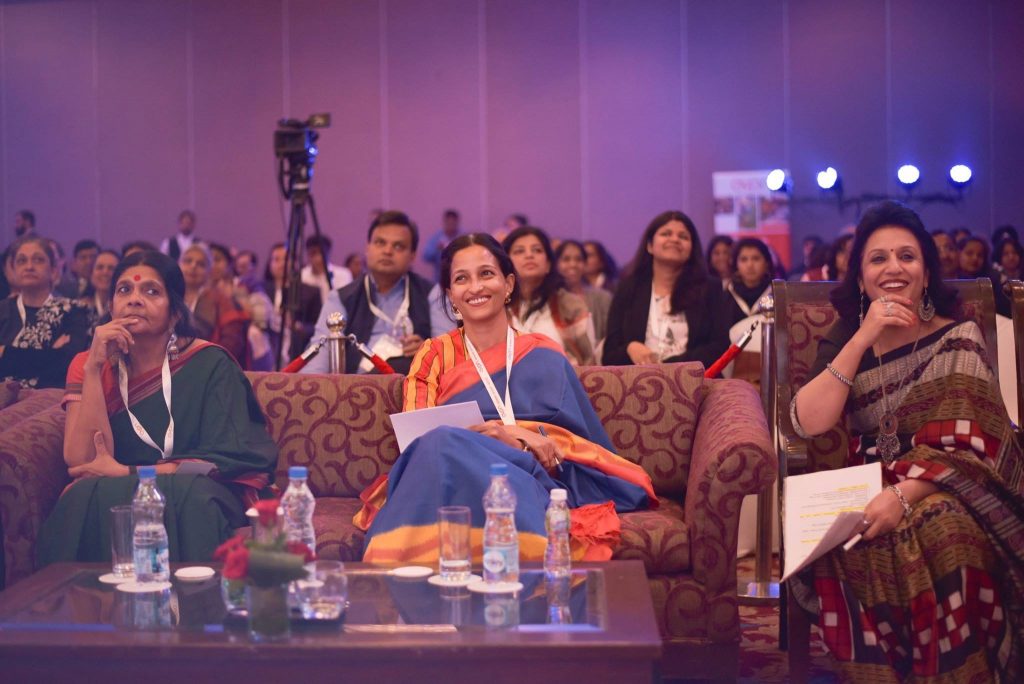5 min read
At the AVPN India Summit 2018, around 260 social investors attended the daylong event. The summit had sessions around the theme of Education, Livelihood, Climate Change, and Nutrition. Eleven sessions featured 46 speakers from philanthropists, intermediaries, universities, and think-tanks. The speakers shared the lessons learned from the unique impactful initiatives of their organizations in the field of social investment. The summit ended with a Deal Share Live session where four SPOs showcased their impactful social programs and initiatives.
Following includes notes from AVPN India Summit 2018 Speakers
Role of Women’s Leadership in Fostering Social Investment
- “Women philanthropists bring a deeper commitment to development as they understand communities and their challenges well”, – Chetna Gala Sinha, Founder-Chairperson, Manndeshi Mahila Sahkari Bank Ltd.
- Women when empowered, not only become leaders themselves but also bring about positive change in their own family, community, and the village. Financial freedom for women brings them agency and power of decision making, in the family, and community at large.
Challenges and Potential of Innovative Funding Models for Development
- “To leverage the shift from traditional grant making to strategic social investment, more and more innovative financing tools should be experimented with, and collaborated on”, – . L. M Singh, Head, USAID PAHAL & Impact Investments at IPE Global.
- Emergence of a young generation of social investors has given rise to innovative models of financing and investing in social programs.
- that ‘social investing’ is more sustainable than doling out grants to social programs, as grants do not ensure scalability of the programs, and even promising programs fall through after the pilot stage.
Human and Intellectual Capital, and the Organizational Advantage
- “Mobilizing human and intellectual capital is crucial for creating high social impact as financial capital alone can’t solve social problems”, – Ravi Sreedharan, Founder, Indian School of Development Management (ISDM).
- Non-Governmental Organizations (NGO) and Social Enterprises (SE), require assistance in gaining access to finances, building capacity of their staff for program implementation, monitoring and evaluation of their programs, for reporting compliance, and legal issues. Intermediary organizations play an important role in bringing this expertise to the NGOs and the SEs. They help the NGOs and SEs channelize their human and intellectual capital to enhance social outcomes of their respective efforts, thus becoming important catalysts of social change.
Innovative models in Early Childhood Care and Education (ECCE)
- “To address the challenges of ECCE, we need to focus on multi sectoral approach. A child’s early childhood is impacted by his immediate environment which in turn is affected by family, WASH, Nutrition and healthcare, education, and livelihoods. To create an impactful ECCE program, all the stakeholders would need to contribute their bit to ensure a holistic childhood care for the children.” – Siddhi Lad, AVP & Head CSR Operations, DHFL
- A child’s early childhood is impacted by his immediate environment which in turn is affected by family, WASH, Nutrition and healthcare, education, and livelihoods. To create an impactful ECCE program, all the stakeholders would need to contribute their bit to ensure a holistic childhood care for the children. There is a need to create a multi-sectoral platform to address the ECCE issues.
Financing the challenging segments of sustainable livelihoods in India
- “Philanthropist should pick up impactful livelihood programs for funding even if they seem challenging, instead of funding the programs that most of the other funders-investors pick up anyway”, – Srinivasan Iyer, Senior Program Manager, Ford Foundation.
- “Corporates need to be educated at different levels- the board of directors, the CEO, and the CSR head, for them to make meaningful investments decisions in livelihood programs through their CSR money”, – Priya Naik, CEO & Founder, Samhita Social Ventures
Rippling effect of Energy Poverty on Education, Health and Livelihoods
- “People have to move on from energy access to energy reliability, and should think about how to keep the population on a renewable energy grid”, – Santosh Kumar Singh, Associate Partner, Intellicap Advisory Services Private Limited
- “It is crucial to involve the bureaucrats from the energy departments of the states, while forming education programs, to provide them a better understanding of how energy access affects education. This helps create a narrative for them”- Vivek Sen, Program Manager, Shakti Sustainable Energy Foundation.
- “Education gets affected by energy crisis like electricity cuts, ill functioning water pumps etc., which is definitely not inspiring students in rural areas to come to schools”, – Gaurav Gupta, Regional Director, Dalberg GlobalDevelopment Advisors.
Empowering India for Job Readiness and Entrepreneurship
- “Investment in skills development will ensure that economic and employment growth is more inclusive.This is especially important in the context of India’s demographic transition that has produced a bulk of youth in the working age of population”, – Anshu Bhartia, CEO, UnLtd India.
- “To address the mammoth challenge of unemployment in rural India, it is important to train rural people for mass entrepreneurship so that they can themselves be employed and can also gainfully employ five or more people”, – Madan Padaki, Founder, Global Alliance for Mass Entrepreneurship (GAME).
Accelerating Innovation in Education through Technology
- “In the rural schools in India, children are at different levels of ability even if they are in the same class. To overcome this challenge for the teachers, dashboards of students’ records help teachers easily track their progress, and dashboards of schools helps the higher officials track the progress of schools. This is how technology aids education”, – Dr Anjlee Prakash, Chairperson, Learning Links Foundation.
- “Teachers need to be trained at regular intervals, and Whats App has emerged as a cost effective tool for delivering teacher training videos, as it is ubiquitously used even in the rural areas”, – Vinod Karate, CEO & Founder, The TeacherApp
- “Technology can be used to aid personalized learning as per the requirement of each student. Such digital platforms can be helpful in the absence of the teacher, when the students can self-learn through videos and tutorial on many topics”, – Pranav Kothari, VP Large Scale Education Programs, Educational Initiatives.
Leveraging strengths of players in nutrition for a Multi-sectoral Alliance in India
- “Nutrition is not only a supply side problem. The behavioral change aspect of people too needs to be addressed”, – Sonali Khan, MD, Sesame Workshop.
- “We should not only rely on government to offer different types of programs to overcome mal-nutrition. There needs to be a multi-sectoral approach to the problem where food security, WASH, education, health, agriculture, and livelihoods sector players need to come together to achieve this”, – Dr. Rajan Sankar, Program Director- Nutrition, Tata Trusts
- “Nutrition is a fundamental block of a child’s life. It only through proper nutrition that every child attains the right to survival, protection , development and participation”, – Dr Antaryami Dash, Nutrition Portfolio Advisor, Save the Children
- “Innovation should ensure that it bridges the gap between the people who are willing to offer the services that promote nutrition, and the ones who are in need of the services”, – Jayanti Shukla, CEO, United Way Mumbai


















